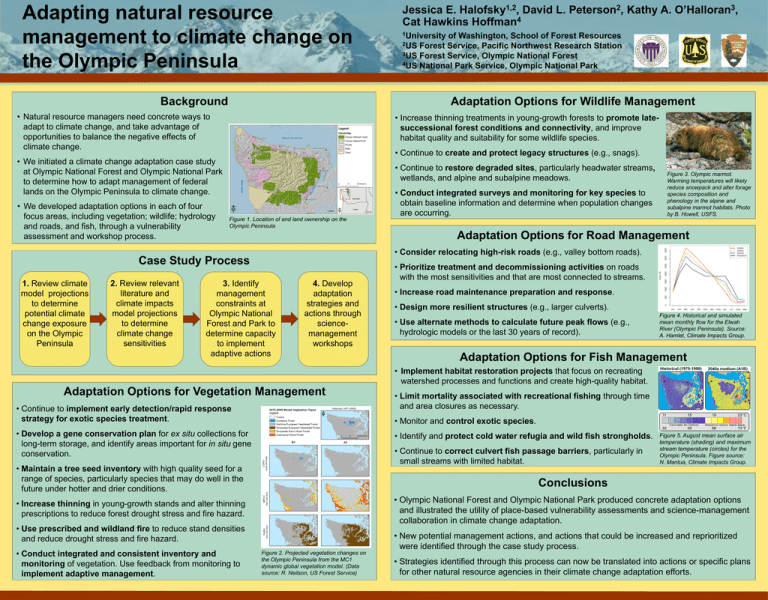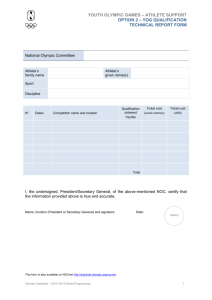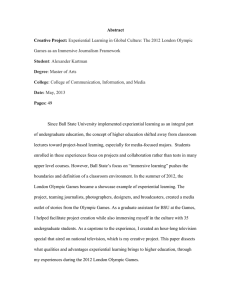Adapting natural resource management to climate change on , Kathy A. O’Halloran
advertisement

Adapting natural resource management to climate change on the Olympic Peninsula Background Jessica E. Halofsky1,2, David L. Peterson2, Kathy A. O’Halloran3, 4 Cat Hawkins Hoffman 1University of Washington, School of Forest Resources 2US Forest Service, Pacific Northwest Research Station 3US Forest Service, Olympic National Forest 4US National Park Service, Olympic National Park Adaptation Options for Wildlife Management • Natural resource managers need concrete ways to adapt to climate change, and take advantage of opportunities to balance the negative effects of climate change. • Increase thinning treatments in young-growth forests to promote latesuccessional forest conditions and connectivity, and improve habitat quality and suitability for some wildlife species. • We initiated a climate change adaptation case study at Olympic National Forest and Olympic National Park to determine how to adapt management of federal lands on the Olympic Peninsula to climate change. • Continue to restore degraded sites, particularly headwater streams, wetlands, and alpine and subalpine meadows. • We developed adaptation options in each of four focus areas, including vegetation; wildlife; hydrology and roads, and fish, through a vulnerability assessment and workshop process. • Continue to create and protect legacy structures (e.g., snags). Figure 1. Location of and land ownership on the Olympic Peninsula Adaptation Options for Road Management • Consider relocating high-risk roads (e.g., valley bottom roads). Case Study Process 1. Review climate model projections to determine potential climate change exposure on the Olympic Peninsula 2. Review relevant literature and climate impacts model projections to determine climate change sensitivities • Conduct integrated surveys and monitoring for key species to obtain baseline information and determine when population changes are occurring. Figure 3. Olympic marmot. Warming temperatures will likely reduce snowpack and alter forage species composition and phenology in the alpine and subalpine marmot habitats. Photo by B. Howell, USFS. 3. Identify management constraints at Olympic National Forest and Park to determine capacity to implement adaptive actions 4. Develop adaptation strategies and actions through sciencemanagement workshops • Prioritize treatment and decommissioning activities on roads with the most sensitivities and that are most connected to streams. • Increase road maintenance preparation and response. • Design more resilient structures (e.g., larger culverts). • Use alternate methods to calculate future peak flows (e.g., hydrologic models or the last 30 years of record). Figure 4. Historical and simulated mean monthly flow for the Elwah River (Olympic Peninsula). Source: A. Hamlet, Climate Impacts Group. Adaptation Options for Fish Management • Implement habitat restoration projects that focus on recreating watershed processes and functions and create high-quality habitat. Adaptation Options for Vegetation Management • Continue to implement early detection/rapid response strategy for exotic species treatment. • Monitor and control exotic species. • Develop a gene conservation plan for ex situ collections for long-term storage, and identify areas important for in situ gene conservation. • Identify and protect cold water refugia and wild fish strongholds. • Continue to correct culvert fish passage barriers, particularly in small streams with limited habitat. • Maintain a tree seed inventory with high quality seed for a range of species, particularly species that may do well in the future under hotter and drier conditions. Figure 5. August mean surface air temperature (shading) and maximum stream temperature (circles) for the Olympic Peninsula. Figure source: N. Mantua, Climate Impacts Group. Conclusions • Olympic National Forest and Olympic National Park produced concrete adaptation options and illustrated the utility of place-based vulnerability assessments and science-management collaboration in climate change adaptation. • Increase thinning in young-growth stands and alter thinning prescriptions to reduce forest drought stress and fire hazard. • Use prescribed and wildland fire to reduce stand densities and reduce drought stress and fire hazard. • Conduct integrated and consistent inventory and monitoring of vegetation. Use feedback from monitoring to implement adaptive management. • Limit mortality associated with recreational fishing through time and area closures as necessary. • New potential management actions, and actions that could be increased and reprioritized were identified through the case study process. Figure 2. Projected vegetation changes on the Olympic Peninsula from the MC1 dynamic global vegetation model. (Data source: R. Neilson, US Forest Service) • Strategies identified through this process can now be translated into actions or specific plans for other natural resource agencies in their climate change adaptation efforts.



